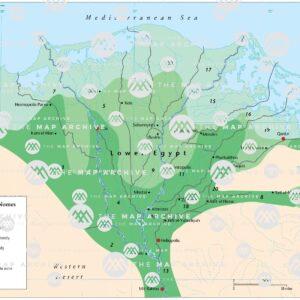Introduction:
The ancient land of Egypt, with its timeless allure and enigmatic history, has captivated the imaginations of scholars and enthusiasts alike for centuries. At the heart of this fascination lies the intricate map of Ancient Egypt, a geographical tapestry woven with the threads of history, culture, and mythology. In this exploration, we embark on a journey through the sands of time, unraveling the secrets held within the contours of the ancient Egyptian landscape.
I. The Nile River: The Lifeline of Ancient Egypt
At the center of the map of Ancient Egypt lies the mighty Nile River, a life-giving force that shaped the destiny of this ancient civilization. Stretching over 4,000 miles, the Nile not only provided sustenance through its annual floods but also served as a natural highway for transportation and trade. The fertile Nile Delta, where the river meets the Mediterranean Sea, became the breadbasket of the ancient world, supporting a flourishing agricultural society.
II. Upper and Lower Egypt: The Dual Kingdom
Ancient Egypt was traditionally divided into two distinct regions: Upper Egypt to the south and Lower Egypt to the north. This geographic division was more than a mere delineation of territories; it held profound cultural and symbolic significance. The White Crown, representing Upper Egypt, and the Red Crown, symbolizing Lower Egypt, were eventually united under the pharaoh Narmer, marking the establishment of the first dynasty and the beginning of a centralized Egyptian state.
III. The Giza Plateau: Guardians of the Horizon
No discussion of the map of Ancient Egypt would be complete without a closer look at the Giza Plateau, home to the iconic Pyramids of Giza. Standing as silent sentinels against the backdrop of the desert, the Great Pyramid of Khufu, the Pyramid of Khafre, and the Pyramid of Menkaure are architectural marvels that have puzzled historians, archaeologists, and astronomers for centuries. The precise alignment of the pyramids with the cardinal points of the compass and their association with the Orion constellation add an extra layer of mystery to these ancient wonders.
IV. The Valley of the Kings: Tombs of the Pharaohs
To the west of the Nile, nestled against the cliffs of the Theban Hills, lies the Valley of the Kings. This necropolis served as the final resting place for many pharaohs and nobles of the New Kingdom. The elaborate tombs, adorned with intricate hieroglyphs and vivid murals, provide a glimpse into the religious beliefs and funerary practices of ancient Egyptians. Among the notable tombs is that of Tutankhamun, the "Boy King," whose burial chamber revealed a treasure trove of artifacts that have since become synonymous with the grandeur of ancient Egyptian artistry.
V. Karnak and Luxor Temples: Monuments to Gods and Pharaohs
On the east bank of the Nile, the temples of Karnak and Luxor stand as testimony to the religious fervor and architectural prowess of ancient Egyptians. The Karnak complex, dedicated to the god Amun, is a vast array of temples, pylons, and obelisks that served as the religious center of Thebes. The Luxor Temple, connected to Karnak by the Avenue of Sphinxes, is a stunning example of symmetry and grandeur, dedicated to the rejuvenation of kingship.
VI. The Oasis of Siwa: Oracle of Amun
Venturing into the western desert, we encounter the oasis of Siwa, a remote haven shrouded in myth and mystery. It was here that the Oracle of Amun resided, providing counsel to those seeking divine guidance. Alexander the Great famously made the arduous journey to consult the oracle, an event that would shape the course of his destiny and the destiny of the known world.
VII. The Eastern Desert: Mines and Trade Routes
Beyond the fertile Nile Valley, the Eastern Desert unfolds—a vast expanse of arid land that played a crucial role in the economic prosperity of ancient Egypt. This region was rich in precious resources, including gold, copper, and gemstones. The trade routes that crisscrossed the Eastern Desert connected Egypt to the Red Sea, facilitating commerce with neighboring regions and distant lands.
Conclusion:
As we trace the contours of the map of Ancient Egypt, we unveil a civilization whose legacy continues to echo through the corridors of time. From the sacred temples and majestic pyramids to the life-sustaining Nile River, each geographic feature tells a story of innovation, spirituality, and resilience. Navigating this map is akin to deciphering an ancient script—a script that invites us to explore the mysteries and marvels of a civilization that has left an indelible mark on the tapestry of human history.





Comments